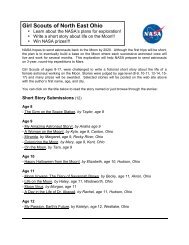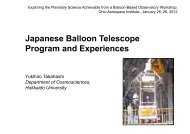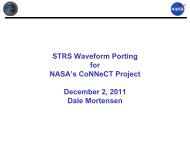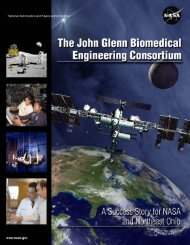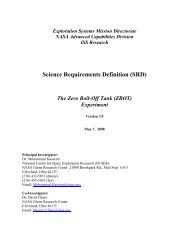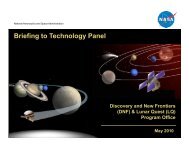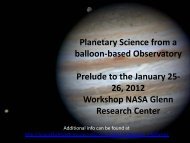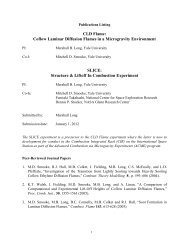Amusement Park Physics With a NASA Twist - Space Flight Systems ...
Amusement Park Physics With a NASA Twist - Space Flight Systems ...
Amusement Park Physics With a NASA Twist - Space Flight Systems ...
Create successful ePaper yourself
Turn your PDF publications into a flip-book with our unique Google optimized e-Paper software.
7. Remove one of the rulers, placing the other ruler so that<br />
it faces the ramp stand directly head-on. Place a marble<br />
at the top of the ruler and release it. Note the direction<br />
that the marble moves after it collides with the ramp<br />
stand (see fig. 4). The marble will rebound directly backward<br />
with the same speed of impact.<br />
Figure 4.<br />
8. Move the ruler so that it is at an angle with the ramp stand<br />
so that the marble will not hit head-on, such as in a sideimpact<br />
collision (see fig. 5). Note the direction that the<br />
marble moves after it collides. The marble will reflect off the<br />
ramp stand with the same speed and angle of impact.<br />
9. Return the marbles to your teacher when you are finished<br />
with this activity.<br />
Figure 5.<br />
Conclusion<br />
1. Describe or illustrate how the marbles moved after they collided head-on in step 3 of the procedure.<br />
Is KE conserved Each marble will move the opposite way after collision with the same speed.<br />
KE is conserved.<br />
2. The marble that was pushed has more KE, because it is moving faster. After the collision, which<br />
marble has more KE The slower marble should move the opposite way with a faster speed having more<br />
KE, and the faster one should rebound at a slower speed than its original speed, having less KE.<br />
3. Although the bumper car riders are strapped in and do not fly out of the car, their heads are<br />
relatively free to move. Two bumper cars have riders that are the same size and mass, but<br />
rider A’s car is moving faster than rider B’s car when the cars collide head-on.<br />
a. What will be the resulting motion of each rider’s head after collision (assuming they stay<br />
attached to the bodies) The riders have the same initial speed as the cars they are riding. The head<br />
of the rider in the faster moving car will lose speed and therefore lose KE when rebounding. The head of the<br />
slower rider will recoil with a faster speed and thus gain KE when rebounding.<br />
b. What will be the resulting motion of the cars after the collision The faster moving car will lose<br />
KE when rebounding and transfer the momentum to the slower car, which will gain KE when rebounding.<br />
4. If the marble sitting still at the bottom of the ramp, in step 5 of the procedure, were twice as massive<br />
as the marble rolling down the ramp, how would the resulting movement of marbles be different<br />
than what you observed Because it is twice as massive, the target marble will move more slowly than the<br />
incident marble. Thus, KE is not conserved.<br />
5. Illustrate or describe the movement of the marbles after the collision that was set up in step 6 of<br />
the procedure. Is the KE of the marbles conserved after the collision<br />
The marbles will move off in a diagonal line from the original paths and at a slower speed. KE is not conserved.<br />
6. How is the direction of movement following the collision in step 7 different from that in step 8 of<br />
the procedure The marble will rebound straight back in step 7, while the marble in step 8 will reflect off the<br />
ramp at the same angle that it hit. However, both examples illustrate the law of reflection, which states that the<br />
angle of incidence equals the angle of reflection.<br />
104<br />
<strong>Amusement</strong> <strong>Park</strong> <strong>Physics</strong> <strong>With</strong> a <strong>NASA</strong> <strong>Twist</strong><br />
EG–2003–03–010–GRC



